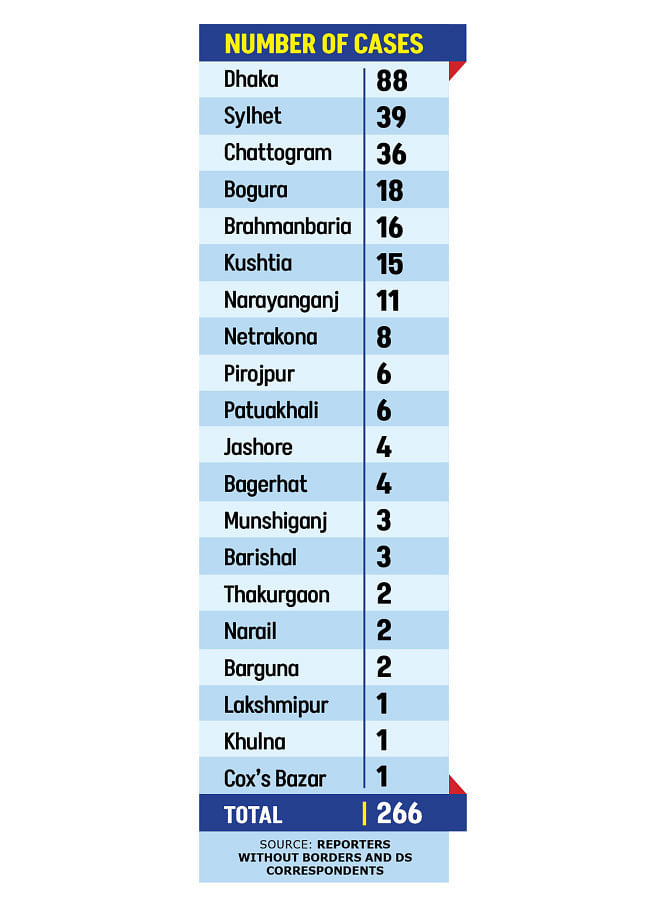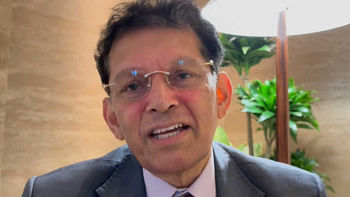World press freedom day: 266 journalists face criminal cases so far

The repression of journalists has taken a new form after August 5, 2024.
Fears for physical safety and instances of judicial harassment are still profoundly visible -- only the actors have changed.
The ghosts of the Digital Security Act hounding journalists have been replaced by more sinister murder and assault charges. Many are bearing the brunt of retaliation for the Awami League government's brutal response to the student-led July uprising.
Over the past few months, as journalists have been booked left and right in cases related to the deadly violence during the uprising, police sub-inspectors and regular criminal courts must deliberate on a question that even media experts struggle to answer: to what extent can journalism incite murder?

"At the former prime minister's press conference on July 26, some top journalists encouraged her to repress the student movement even harder. It is clear that they were not acting as journalists, but rather as political activists," said Kamal Ahmed, a journalist who had headed the Media Reform Commission. By July 26, scores of citizens, including children, had been killed indiscriminately by the law enforcers.
But the answer to whether journalism can be linked to murder becomes more tangled the further one descends the hierarchical ladder, the deeper one goes into the districts and upazilas where local correspondents work under duress.
To get a clear picture, The Daily Star compiled figures from Reporters Without Borders (RSF) and information from the newspaper's own network of local correspondents.
This newspaper has found that at least 266 journalists have been implicated in various cases related to the events of July and August last year.
The highest number of those cases has been filed in Dhaka -- 88. Sylhet and Chattogram come second and third, respectively, with 39 and 36 journalists prosecuted.
Savar, Narayanganj, Kushtia, Brahmanbaria and Bogura saw between 10 and 20 journalists prosecuted in each of these districts.
The other districts where journalists faced murder charges or cases filed over July-August violence include Cox's Bazar, Khulna, Lakshmipur, Barguna, Narail, Patuakhali, Thakurgaon, Barishal, Munshiganj, Bagerhat, Jashore, Pirojpur and Netrakona.
Nearly 50 media organisations, from top national newspapers and television stations to local publications, have been impacted by these cases.
The Daily Star also attempted to find overt political links that the journalists might have had with the Awami League, which could suggest that they may have been targeted with cases for reasons other than journalism.
There were a few clear-cut cases. For example, in Narayanganj, two district correspondents were spotted in videos accompanying deposed lawmaker Shamim Osman during a rally where his followers fired on student protesters. One of the journalists was seen in a video carrying a firearm in each hand as the violence ensued.
But overall, only 18 percent of the journalists prosecuted -- about 50 -- had overt political stripes or benefitted from the AL regime.
The majority were the victims of retaliatory cases.
For example, in Sylhet, Monwar Jahan Chowdhury, a UK expatriate and UK correspondent of Daily Shomoyer Alo, was accused in a case even though he moved to the UK a couple of years ago, reports our correspondent.
Also in Sylhet, Khalilur Rahman, a fellow journalist and former general secretary of Bangladesh Khelafat Majlish, filed a case with Kotwali Police Station on August 27 last year, naming nine journalists. The case is now under investigation by the Police Bureau of Investigation.
In Brahmanbaria, retaliatory cases were not only filed regarding incidents of the July-August movement but also the protests and clashes surrounding Indian Prime Minister Narendra Modi's visit to Bangladesh on March 26, 2021. A total of 16 journalists face cases in this district, and at least two journalists, working for two national newspapers, have lost their jobs for being accused in the cases.
On November 24, a murder case was filed at the International Crimes Tribunal against 14 journalists, including Dhaka Tribune's Khulna Correspondent Md Hedait Hossain, on allegations that they had electrocuted a boy to death.
The complaint says that Rakibul Hasan, a resident of Paikgachha upazila in Khulna who was involved in the Anti-Discrimination Student Movement, was electrocuted while hoisting a flag tied to a bamboo pole during a protest on August 5.
The first information report alleges that the accused intentionally connected live electric wires to bamboo and electric poles on the protest route, which led to Rakibul's electrocution and immediate death.
The journalist, Hedait, had previously been arrested under the Digital Security Act for his reporting during the December 30, 2018, national election and battled the case for two years.
"In both regimes, I have become the victim of the abuse of political powers. I was named because I belong to the Federal Union of Journalists. I had contacted the father of Rakibul, and he said that he does not even know about the case. He said that three people came to his house and took his NID, claiming that they would get financial assistance from the government. He told me that he gave his signature to the men on a white paper," said Hedait.
He was also named in another ICT complaint filed over a death in Ashulia that happened at the same time as Rakibul's death, even though Hedait is from Khulna. "Strikingly, both complaints cited the same witness. How can one witness be both at Ashulia and Paikgachha at the same time?" he questioned.
At least 14 journalists have been arrested at various times, with 13 of them still in jail.
One of them, Monirul Islam, the Kuakata correspondent of GTV, was later released on bail. He explained how the case against him was fabricated.
"I was named in a case filed under the Explosives Act. The incident happened on August 4, when a few local boys allegedly threw cocktails at a shop in Kuakata. I was not even in that location, and I had all the proof. I was in Dhaka. I was so sure that it was a mistake that I went to the court and surrendered, but instead of taking my proof into cognisance, they threw me into jail," said Monirul. He spent 16 days behind bars.
Monirul is afraid of being too vocal about the case, fearing further persecution. "I need to stay in my district, because if I cannot, I will lose my job," he said.
Former reform commission chief Kamal said one of the reasons that journalists at the local level are being targeted is because many of them have side gigs like businesses. "Many have multiple identities, and these fake murder charges are a way of score-settling or a result of political rivalry," he said.
"These cases need to be independently investigated to find out the underlying reasons behind them, and the police cannot be the ones to do it. But for sure, these reasons are not linked with the offences they are actually being prosecuted for," he said.
When asked why murder cases were being filed against journalists, Dhaka Metropolitan Public Prosecutor Omar Faruq Faruqi told The Daily Star, "They (journalists) might not be directly involved, but they aided and abetted through their speeches."
The question arises: how many of the prosecuted journalists, especially out of the capital, wielded the clout necessary to incite Awami League cadres or law enforcers to commit murder?
Kamal Ahmed said these cases were unequivocally made on trumped-up charges and that the murder charges were all false.
"There is no specific law in Bangladesh that can prosecute a journalist for incitement of murder through journalism. There are laws that can be used against journalists for breaking down social harmony," he said.
In a report in January, Human Rights Watch called the wholesale prosecution of journalists a replication of the "familiar patterns of abuses from the Hasina administration".
"While it is critical that those who were involved in commanding, aiding, and abetting the grave crimes committed during the uprising are held to account, mass cases against journalists for not backing the protesters sends a dangerous message for freedom of expression under the interim government," the report said.
Beyond judicial harassment, all the journalists The Daily Star spoke to said they were afraid of mob attacks that would "invariably go unchecked".
At least 28 journalists were attacked in seven separate instances across Natore, Barishal, Patuakhali, Shariatpur and Dhaka.
Omar Faruk, who had formerly worked at Independent Television, was attacked while covering the demolition of the house of Sheikh Mujibur Rahman on Dhanmondi 32.
"I went live and was explaining to my audience that the authoritarian rule of Sheikh Hasina had led to intense public outrage. I used the word 'Bangabandhu' to refer to Sheikh Mujibur Rahman. After all, even the museum located here was called the Bangabandhu Museum. A mob gathered around me because I used that word, and they beat me up," said Faruk.
Faruk said he filed a general diary with the local police station, but there was no update on the investigation.
"I have no hope for justice. Mobs know that they can attack journalists with impunity," he said.
Célia Mercier, head of the RSF South Asia Desk, said in a report on February 14 that there was a worrying surge in violence against the media.
She said, "While the interim government's takeover in August 2024 raised hopes for improvement, journalists' safety remains unprotected. They are being assaulted while reporting, subjected to physical retaliation for their articles, and their newsrooms are being stormed by protesters.
"RSF calls on the authorities to prosecute all those responsible for these attacks, to put an end to this intolerable cycle of violence, and to ensure the safety of media professionals."
[Our district correspondents contributed to this report.]

 For all latest news, follow The Daily Star's Google News channel.
For all latest news, follow The Daily Star's Google News channel. 




Comments